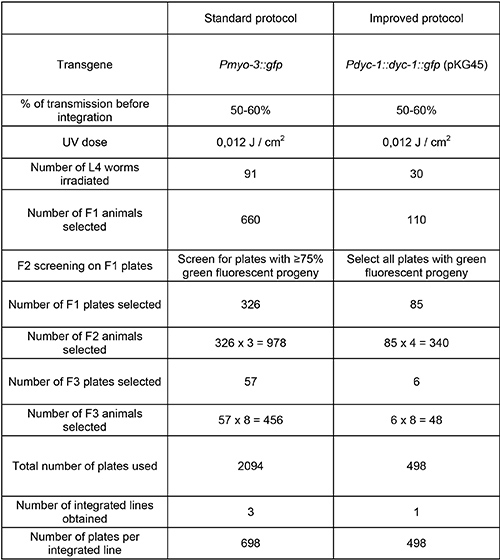A subscription to JoVE is required to view this content. Sign in or start your free trial.
UV Irradiation: A Method to Integrate Extrachromosomal Arrays
In This Article
Overview
Microinjection of transgenes usually results in C. elegans strains with large extrachromosomal arrays, which result in variable expression and transmission of the transgene. UV Irradiation can induce chromosomal integration of the array and more stable transgene transmission.
Protocol
This protocol is an excerpt from Mariol et al, A Rapid Protocol for Integrating Extrachromosomal Arrays With High Transmission Rate into the C. elegans Genome, J. Vis. Exp. (2013).
1. UV Irradiation and Recovery of Transgenic Worms
- Worm irradiation:
- Pick 30-100 fluorescent transgenic L4 animals onto separate culture plates (15-20 animals by plate).
- Place the plates, with the lids removed, in a UV cross-linker. Irradiate the worms at 0.012 J/cm2. Note that strains are more or less sensitive to UV and that results can be variable depending on the UV irradiator used. A dose range between 0.010-0.015 J/cm2 can be tested.
- Worm recovery after irradiation:
- Place plates with irradiated worms overnight at 15 °C for recovery.
- Check for the number animals that are alive. In our hands, a survival rate of around 80-90% is adapted for an efficient irradiation.
- Grow the irradiated animals at 15-25 °C until the progeny has reached the developmental stage allowing for the observation of the coinjection marker expression.
2. Isolation of Integrated Transgenic Lines
- Selection of F1 animals:
- Single 150-200 fluorescent F1 animals onto separate culture plates. For highly transmitting lines (≥80%), 100 F1 animals are enough.
- Keep these F1 plates at 15-25 °C until the progeny reaches an appropriate stage for the observation of fluorescent F2 animals.
- Discard all F1 plates exhibiting either i) no progeny, indicating that the F1 animal was sterile or died, or ii) no or only few fluorescent F2 animals, indicating that the F1 animal did not transmit the transgene at the expected rate. This step is quick and represents a real advantage when compared to the standard protocol that requires an estimation of the percentage of fluorescent F2 worms in order to select F1 plates exhibiting ≥75% fluorescent progeny (Table 1).
- Selection of F2 animals:
- Single four fluorescent transgenic F2 animals from each selected F1 plate. When using fluorescent transgenes (for example mCherry, gfp, or dsRed), pick F2 worms with a high level of fluorescence as this could indicate that these animals are homozygous for the integrated array. Note that when picking F2 animals it is critical not to carry along eggs or larvae, in order to avoid false negatives in the next step.
- Grow F2 animals at 15-25 °C.
- Isolation and validation of integrated transgenic strains:
- Screen F2 plates for 100% fluorescent transgenic F3 worms. The screen is quite rapid as the presence of a single nonfluorescent worm indicates that the plate should be thrown away. A F2 animal homozygous for the integrated transgene will give 100% homozygous fluorescent progeny.
- Single eight fluorescent F3 animals from selected plates to confirm the 100% inheritance of the transgene. In theory, picking one animal is enough at this step. However, picking eight fluorescent F3 animals may be necessary to avoid selecting unfertile or unhealthy animals as irradiation can randomly induce mutations that affect genes important for worm physiology.
- If possible keep several independent integrated transgenic strains, i.e. strains recovered from different F1 animals.
Access restricted. Please log in or start a trial to view this content.
النتائج

Table 1. Comparison of the standard and improved protocols for extrachromosomal arrays integration into the C. elegans genome. Two nonintegrated transgenes transmitting at about the same frequency were integrated using the standard or the improved protocol. The main difference lies in the fact that in the standard protocol a screen of the proge...
Access restricted. Please log in or start a trial to view this content.
Materials
| Name | Company | Catalog Number | Comments |
| U.V. cross-linker | Fischer Scientific | Wavelength 254 nm | |
| Microscope SteREO Discovery V8 | Carl Zeiss, Inc. | ||
| Petri dishes, 60 mm | CML | BPS55E6 | |
| Platinium wire 0.25 mm | Alfa Aesar | 6/4/7440 | To make a pick for worms |
References
Access restricted. Please log in or start a trial to view this content.
This article has been published
Video Coming Soon
Source: Mariol, M. C et al. A Rapid Protocol for Integrating Extrachromosomal Arrays With High Transmission Rate into the C. elegans Genome. J. Vis. Exp. (2013).
Copyright © 2025 MyJoVE Corporation. All rights reserved